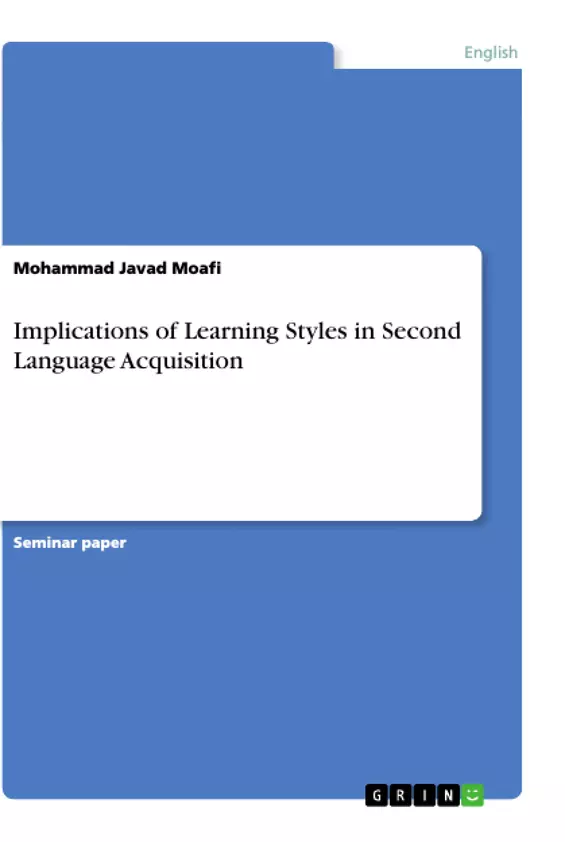There is little doubt that language learning is a multifaceted process affected by many factors whether internal or external. In terms of internal factors, Brown (2007), for instance, divide them into cognitive factors like learning styles, and learning strategies as well as affective factors including motivation, attitude, anxiety, self-esteem, types of personality, etc. In his taxonomy of individual differences affecting SLA, Ellis (2008) categorizes them into four areas: Abilities which includes intelligence, working memory, and language aptitude, Propensities including learning styles, motivation, anxiety, personality, and willingness to communicate, Learner cognitions such as learner belief, and finally learner actions like learning strategies. However, due to the time restriction, it is impossible to cover all of these factors once at a time. Therefore, this paper tries to focus on the learning styles as an internal cognitive variable affecting language learning.
Inhaltsverzeichnis (Table of Contents)
- Definition and Basic Conceptual Issues
- Learning Styles Taxonomies
- Kolb's learning style construct (1984)
- Ehrman and Leaver's cognitive styles (2003)
- Reid's learning styles categories (1995)
- Sensory Learning Styles
- Field Dependence-Independence Cognitive Style
Zielsetzung und Themenschwerpunkte (Objectives and Key Themes)
This paper explores the significance of learning styles as an internal cognitive variable affecting language learning. It aims to provide a comprehensive overview of learning styles, their definitions, taxonomies, and implications for second language acquisition (L2).
- Defining learning styles and differentiating them from abilities and cognitive styles
- Examining different learning styles taxonomies and their theoretical foundations
- Analyzing the impact of sensory learning styles on L2 acquisition
- Investigating the role of field dependence-independence cognitive style in L2 learning
- Highlighting the importance of considering individual differences in language learning
Zusammenfassung der Kapitel (Chapter Summaries)
- Definition and Basic Conceptual Issues: This chapter defines learning styles and distinguishes them from abilities and cognitive styles. It examines various perspectives on learning styles and their significance in language acquisition.
- Learning Styles Taxonomies: This chapter presents different learning styles models and taxonomies, including Kolb's learning style construct, Ehrman and Leaver's cognitive styles, and Reid's learning styles categories. It provides an overview of the theoretical frameworks underlying these classifications.
- Sensory Learning Styles: This chapter focuses on sensory learning styles, outlining the characteristics and preferences of visual, auditory, kinesthetic, and tactile learners. It highlights how these preferences influence learning experiences and classroom activities.
- Field Dependence-Independence Cognitive Style: This chapter explores the field dependence-independence cognitive style, explaining how individuals with different styles perceive and process information. It examines the implications of this style for language learning, particularly in terms of analytical vs. holistic approaches.
Schlüsselwörter (Keywords)
This paper focuses on cognitive factors, learning styles, and learning strategies in the context of second language acquisition. It examines different learning style taxonomies, including sensory learning styles, field dependence-independence, and personality-based learning styles. The paper emphasizes the importance of understanding individual differences in learning and its implications for successful language acquisition.
- Quote paper
- Dr. Mohammad Javad Moafi (Author), 2016, Implications of Learning Styles in Second Language Acquisition, Munich, GRIN Verlag, https://www.hausarbeiten.de/document/593780


